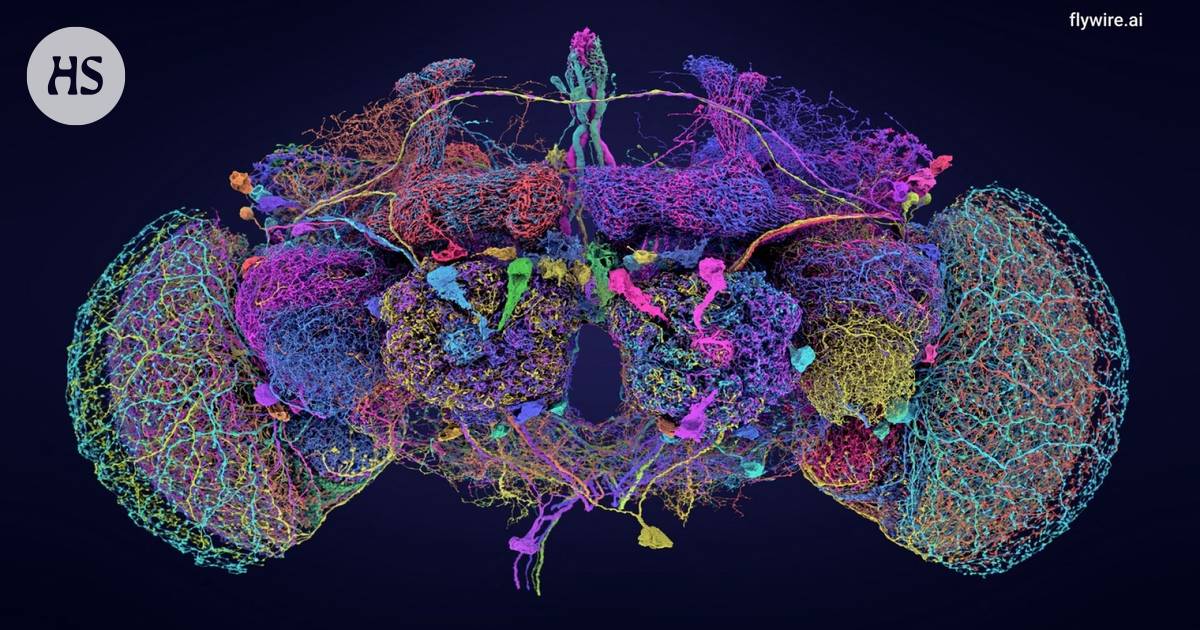Brain research|The brain of the banana fly has now been mapped down to every cell and connection.
The summary is made by artificial intelligence and checked by a human.
The researchers mapped the brain of the banana fly. The map has more than 139,000 brain cells and their approximately 50 million connections in their correct place.
The map is the first complete mapping of the brain of an adult animal.
The study was carried out by the Flywire Consortium, an international project of brain researchers. The results were published by the scientific journal Nature.
The map promotes research on the human brain and brain diseases. Neuroscientists estimate that a similar accurate map of the human brain may be completed in about 30 years.
Banana fly is a household kitchen annoyance that everyone is familiar with. For researchers, the fly has offered a way to study the inner workings of one animal’s nervous system.
One endpoint has now been reached. The brain of the banana fly has been mapped down to every cell and connection.
The work is quite certainly helpful to the person. About 60 percent of the banana fly’s genes are the same as humans.
The aging of a banana fly, for example, resembles the aging of a human. Flies also get drunk. Another pleasure substance, coffee, also keeps the little fly awake.
Much more can fit in a brain that is smaller than the head of a pin.
The brain researchers say that they have now, as a team, located every fly’s brain cell. There are almost 140,000 neurons in the brain.
More than 54 million connections to other brain cells emanate from these cells. Together they form the brain’s intricate neural network, connector.
More than 8,400 different cell types were found in the brain. Many of them are completely new to researchers, he says science journal Science’s news.
The banana fly (Drosophila melanogaster) is one of the most studied animals in the world.
Map is the first brain mapping of an adult animal. The work has been described as one of the breakthroughs in brain research.
“What are brain connections? How do signals flow in the brain in such a way that we can recognize faces, hear other people’s voices, and even turn words into electrical signals?”
That’s what you asked Interviewed by the BBC a brain scientist Gregory Jefferis From the UK Medical Research Council Molecular Biology Laboratory, Cambridge, England.
“The brain of a fly helps us get an idea of how our own brain works.”
Humans have a million times more brain cells and nerve cells than a banana fly.
The study was carried out by a large international network of researchers Flywire Consortium. He presented the brain map science journal Nature.
From mapping the published pictures are beautiful, but they also reveal the immense intricacy of the brain map.
The structure of the map is key when researchers figure out how an organ as small as a fly’s brain can perform so well.
For example, man has not yet been able to make a single small computer that works as cleverly as the brain of a banana fly.
“Now we can compare healthy and diseased brains when something goes wrong,” says one of the leaders of the survey, Dr. Mala Murthy from Princeton University, USA.
RESEARCHERS have previously mapped the brains of smaller organisms, such as a simple worm. There were only about 300 cells to map then. The work was completed in March 2023.
“A complete map of 140,000 brain cells is an amazing achievement,” said the doctor to the BBC Lucia Prieto Godino. He is head of the brain research team at the Francis Crick Institute in London and was not involved in the fly mapping.
He says the map paves the way for larger mappings, next perhaps a map of the mouse brain, and eventually a complete map of our own brains.
BRAIN CELLS the connections were found when the fly’s brain was sliced into slices with microscopic blades.
Each of the 7,000 slices was imaged under a high-precision microscope. The images were then encoded into digital format.
The researchers also used artificial intelligence to help. With its help, the shapes and connections of all neurons could be distinguished from each other.
Map on available to all researchers. Researchers believe that with the help of the map, neuroscience will prove many new discoveries in the next few years.
Brain researchers estimate that a similar accurate map of the human brain could be completed in perhaps 30 years.

Oslo Trefelling: phone – Bernt Ankers Gate 8, Chelmsford
Oslo Trefelling, Oslo, NO | Informations sur l'entreprise
avavav1919 (총판온 : 국내1위 총판커뮤니티) / 작성글 – velog
avavav1919 (총판온 : 국내1위 총판커뮤니티) / 작성글 – velog
토토총판모집
rentry.co/6nkeh5fm/raw
토토총판의 수익구조와 정산방법
총판온 on Walk Score
Page Not Found | Mixcloud
총판온 : 국내1위 총판커뮤니티's Shows | Mixcloud
http://www.tuugo.us
Error 404 – Page not found
expatriates.com – page not found
File or folder not found
Morris & Dean, LLC – Accident and Injury Lawyers, Dalton
AddonBiz Local Business Directory, Add Your Business Free
http://www.businessintelligencelist.com
Morris & Dean, LLC – Accident and Injury Lawyers in Dalton, GA
BatchGeo: Make a map from your data
Morris & Dean, LLC – Accident and Injury Lawyers
MapFling™
Morris & Dean, LLC – Accident and Injury Lawyers in Dalton, GA Services Offered Legal Classifieds | N2Local
Certificate verification problem detected
Certificate verification problem detected
Independent Rent A Car – BC
Independent Rent A Car – Vancouver, BC
Write In Private: Free Online Diary And Personal Journal | Penzu
Independent Rent A Car Official Homepage
Independent Rent A Car – Vancouver, BC
businesseslisted.com